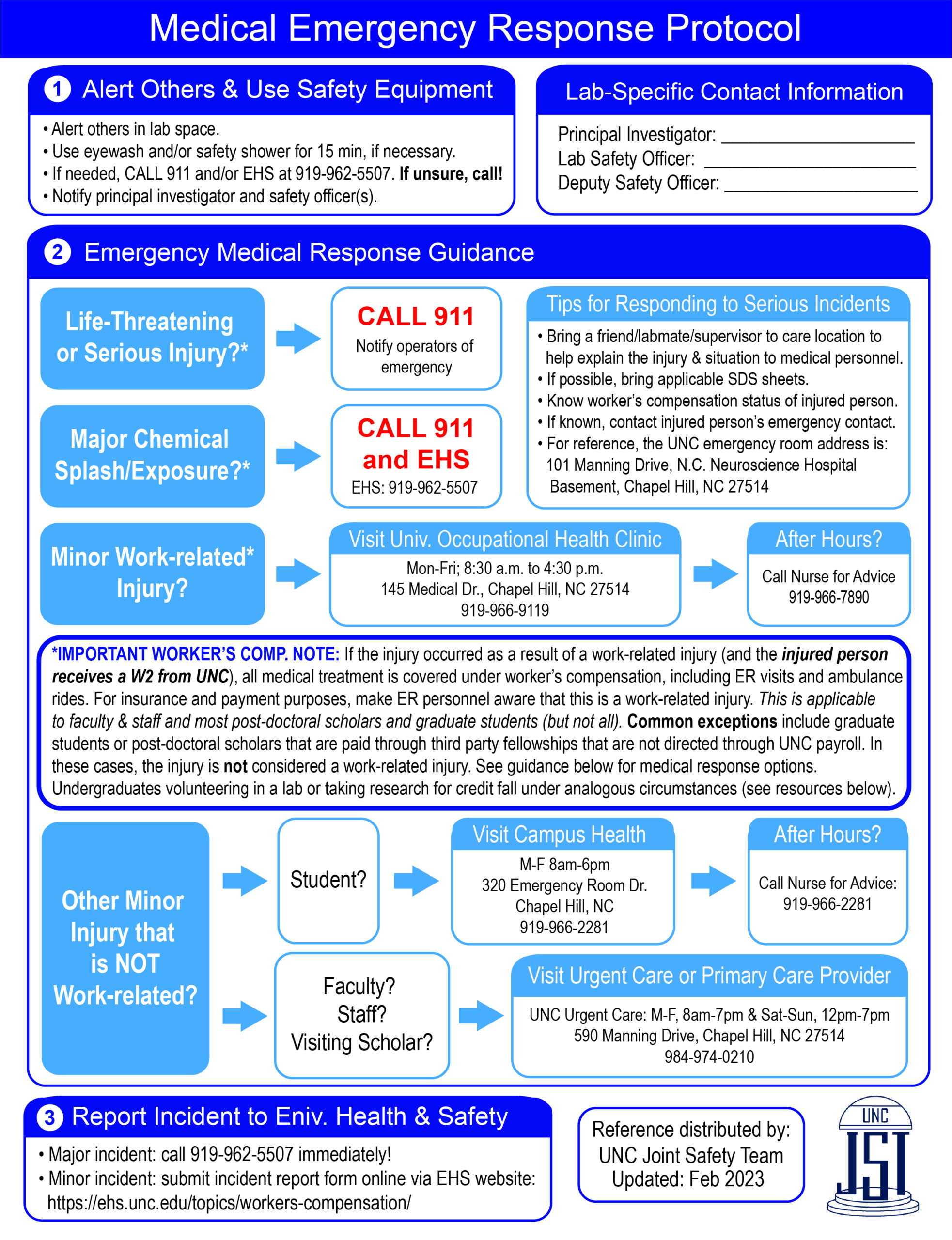Emergency Response
If you or someone you know is in immediate danger or needs urgent medical care, CALL 911.
- General Emergency – CALL 911
- Provides fire, immediate medical and/or police response
- Environmental Health & Safety – 919-962-5507
- Equipped to respond to a variety of emergency situations including but not limited to chemical spills, blood/biohazard spills, illegal dumping, unknown odors, natural gas odors, and safety hazards.
- Note: If no one answers the EHS phone, leave a message with your name, contact information and a general synopsis of the situation. EHS will be paged to respond as soon as possible.
- Facilities
- Emergency Repairs – 919-962-3456
- General Maintainence & Repairs:
Cale Rogers, Facilities Maintenance Technician for Chemistry Dept – (919) 843-7736
Jason Worrell, Facilities Manager – (919) 619-7800
- UNC Police Non-Emergency Phone – 919-962-8100
- For non-emergency calls to report crimes and/or suspicious activity
- University Employee Occuational Health Clinic – 919-966-9119, 145 North Medical Drive
- Provides occupational health care services to all part-time, full-time, and temporary employees of the University of North Carolina at Chapel Hill.
- Point-to-Point (P2P) – 919-962-7867
- Transportation service for students, faculty, and staff
- Fixed-route bus services are available, as well as on-demand transportation to Campus Health, Occupational Health or UNC Hospitals’ Emergency Room (call for service)
- Emergency conditions requiring treatment en route such as bleeding or other severe health issues must be addressed to the Orange County EMS service. Call 911.
- Department Chair
Wei You – 919-962-4358 - Chemistry Department, Associate Chair of Research
Ralph House – 919-962-5518 - Not Sure Who to Call?
- Check out EHS’s “Who Do I Call?” List for more information!
Coming Soon!
All information is sourced from the UNC EHS Workplace Safety Website.
UNC employees are required to notify their supervisor immediately of any job-related injury or illness (including near misses). See the UNC EHS resources below for more information. Worker’s Compensation Employee & Supervisor Incident Report Forms

https://ehs.unc.edu/topics/workers-compensation/
https://ehs.unc.edu/topics/workers-compensation/
Many laboratory spills are of limited hazard potential, and laboratory personnel can clean up safely. Your laboratory should be equipped to handle small low-hazard spills. You should call EHS (919-962-5507) if a spill situation involves any of the following:
- a respiratory hazard
- a threat of fire or explosion
- more than 100 mL of an OSHA regulated chemical carcinogen or a highly toxic chemical
(see appendices to Chapter 7) - more than 1 liter of a volatile or flammable solvent
- more than 1 liter of a corrosive (acid or base) liquid
- elemental (liquid) mercury spills; refer to section C below
See UNC EHS Laboratory Safety Manual for additional advice & protocols.
General Response Steps for Chemical Spills
Step 1: Leave and Control Spill Area
- Evacuate personnel from the immediate spill area.
- Block off immediate spill area – close corridor doors, use lab carts, wastebaskets, etc.
- Eliminate any fire hazard, especially if spill is flammable or combustible- turn off burners, electrical equipment, etc.
- Post sign, “Spill Area – Keep Out”.
- Alert other personnel in laboratory and adjacent areas of a chemical spill including the PI or Instructor.
Step 2: Help Injured Personnel
Take care of injured personnel- move from spill, remove contaminated clothing, flush skin with water, use eyewash and/or safety shower, etc. If there is a chemical splash to the eyes and/or there are burns or respiratory problems, seek medical attention.
Step 3: Evaluate Hazard
Make preliminary evaluation of hazard and identification of risks and decide whether you should call EHS. If it can be handled without respiratory protection, continue with clean up.
Step 4: Clean Up Spill
- Contain the spill using absorbent clay to stop spill from spreading under refrigerators, cabinets, equipment, drains, or corridors. Then spread clay around the perimeter, damming the spill.
- Use the clay to absorb the rest of the liquid.
- Scoop the clay/absorbed chemical mixture into a plastic pail lined with a plastic bag.
- Seal plastic bag and containerize for disposal.
- Wash and deactivate the spill surfaces of trace amounts of the spilled chemical. Contact EHS for advice.
- Fill out Electronic Hazardous Material Pick-Up Request for collected spill material or call EHS for disposal instructions.
- Replace used materials in spill kit.
Step 5: Review Incident
See UNC EHS Laboratory Safety Manual for additional advice & protocols.
UNC EHS Mercury Spills Resource
Response details are available at the following link.
Section XVI, Subsection C.
https://policies.unc.edu/TDClient/2833/Portal/KB/ArticleDet?ID=132013#divAttachments
UNC EHS Hydrofluoric Acid Spills Resource
Response details are available at the following link.
https://policies.unc.edu/TDClient/2833/Portal/KB/ArticleDet?ID=132018
General Procedures:
If you see a fire, activate the fire alarm and call 911.
When a fire alarm sounds,
- Evacuate immediately at the closest emergency exit.
- When leaving the building, close all windows, doors, and fume hoods. This will stop the fire from spreading.
- If you encounter smoke, drop down & stay low to the floor until you reach the exit.
- Evacuate the building using the stairs. Never use the elevator, in case power is lost.
- Meet at your lab’s designated assembly area, as designated in your lab’s Emergency Action Plan.
- For those who are physically impaired, shelter in place in the building’s designated “place of refuge.”
*adapted from UNC EH&S policies (see resource below for more details)
UNC EHS Fire Emergency Procedure
https://policies.unc.edu/TDClient/2833/Portal/KB/ArticleDet?ID=131935
